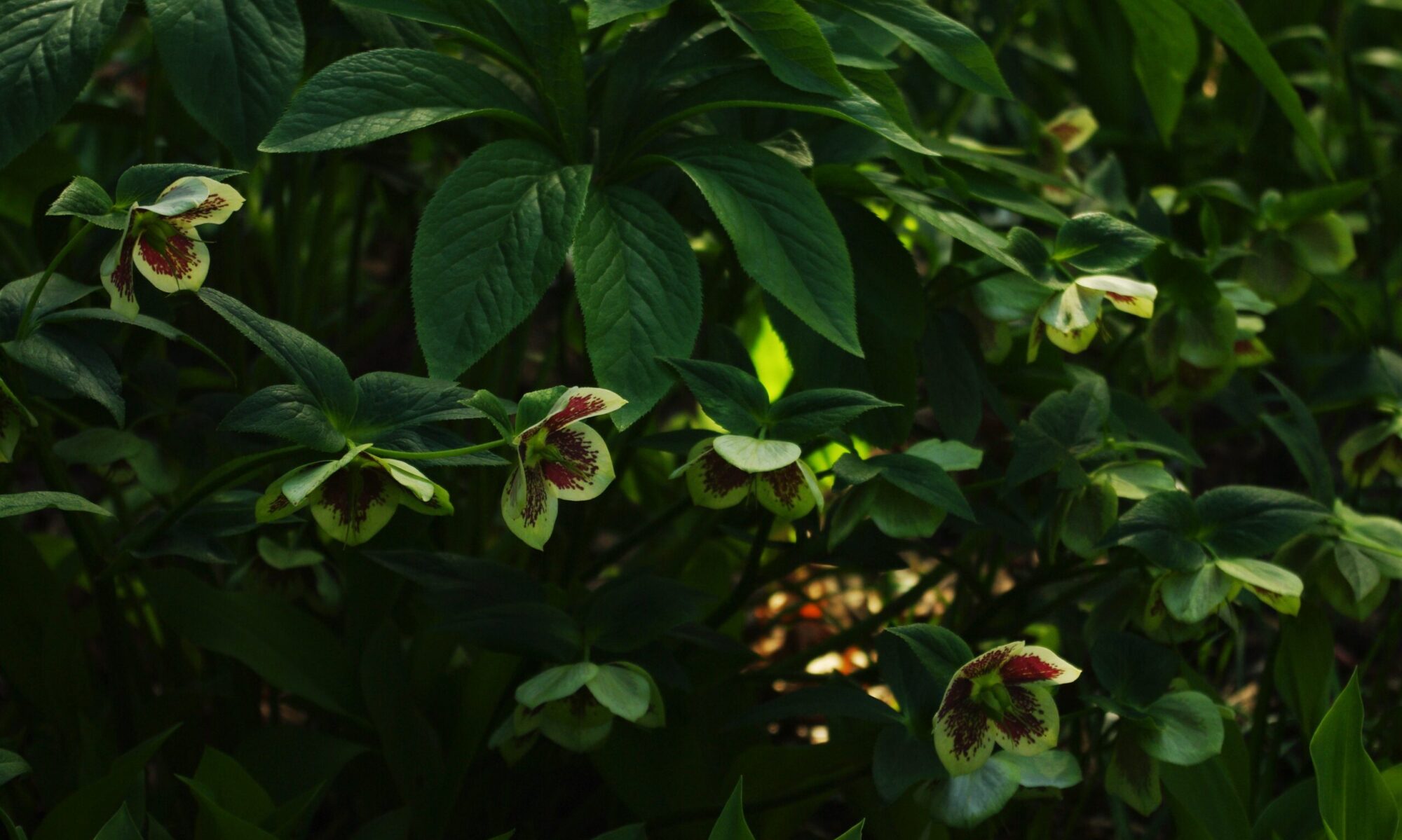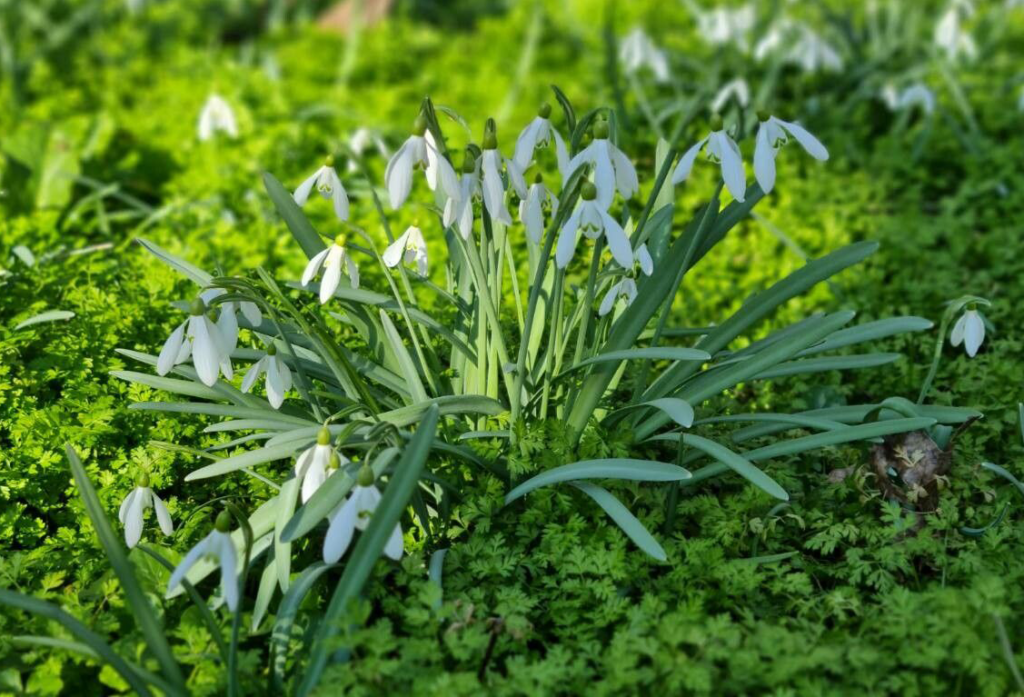
Below is our small selection of our favourite bulbs which will be available in the autumn of this year. These span a variety of species and families but share a common trait – they are gorgeous and easy to grow.
Anemones
Anemones are impressively long lasting in arrangements, making them a florist favourite. Give them a semi-shaded location with moist, well-drained soil, and they’ll give you a spectacular show for weeks on end!
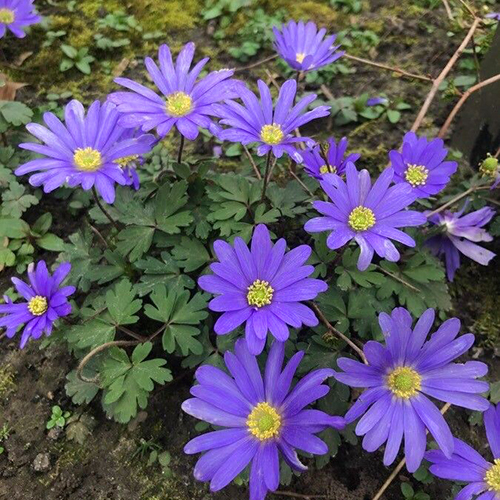
This award-winning Grecian Windflower creates lovely mounds of daisy-like flowers (2” across) over a finely cut fernlike foliage in mid spring and spreads to form a carpet of blooms. Extremely popular due to its early and massive flowering and ability to naturalize easily. Corms will multiply and continue to appear in spring for years and years to come. Plant in sun or part shade. 4-6”
20 / $7.50
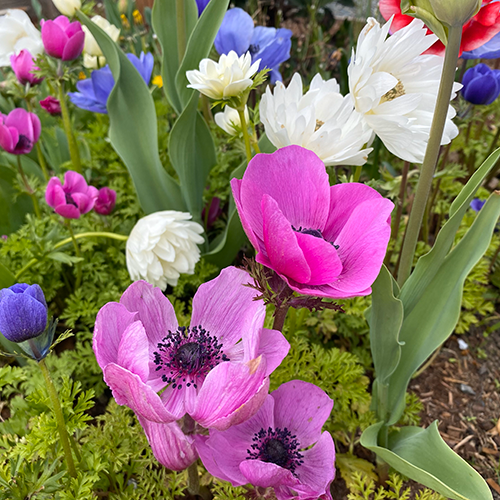
The astonishing rainbow of ornate, double-flowering anemone blossoms featured in the St. Brigid mix will bring bright cheer to the spring garden. Deer resistant. Good cut flower. 10-12″.
10 / $6.50
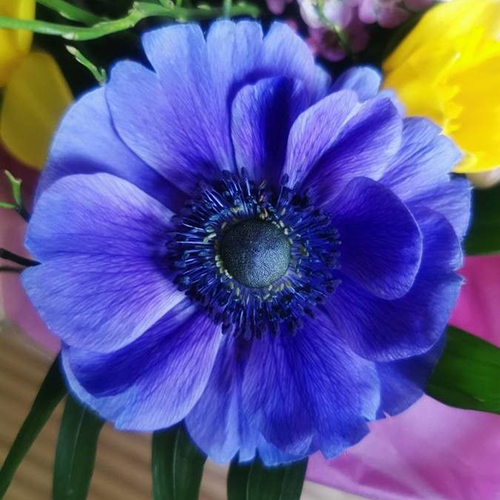
This anemone boasts satiny, violet-blue, poppy-like flowers adorned with a dark button center. Blooming in mid to late spring, they usually last up to 4 weeks. Borne atop sturdy stems above clumps of finely divided, ferny leaves, they attract butterflies and make wonderful cut flowers. They thrive in the sunny garden where their broad, bright faces are highly appealing. Perfect for beds, rockeries or containers, and an absolute must for the cutting garden. 8-10”.
10 / $5.00

This may be the dreamiest Anemone variety we know! Luxurious, velvety, iridescent petals form a rich, dark plum cup adorned with a vibrant purple eye and powdery dome of black stamens. Excellent cut flower. Full sun- light shade. 8-12″
5 / $7.50

Beautiful large, ivory white flowers up to 4” across open in late spring- early summer to reveal their dark, purple hearts. ‘Carmel White’ is new to the market and is prized for its large, single white blooms with striking dark centres. Borne atop sturdy stems above clumps of finely divided, ferny leaves, they attract butterflies and make wonderful cut flowers. They thrive in the sunny garden where their bright faces are highly appealing. Perfect for beds, rockeries or containers, and an absolute must for the cutting garden. 16”.
5 / $7.00
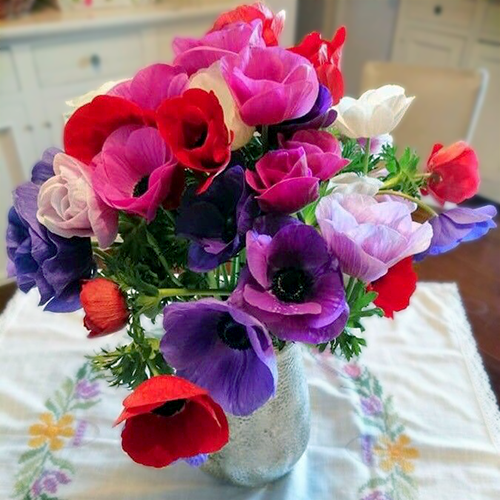
Anemone coronaria De Caen Gem Mix offers a mix of colours blooming in mid to late spring. The De Caen cultivars were bred in the regions of Caen and Bayeux, France in the 18th century. Terrific in the garden, in containers and in the vase! 10″
10 / $5.00
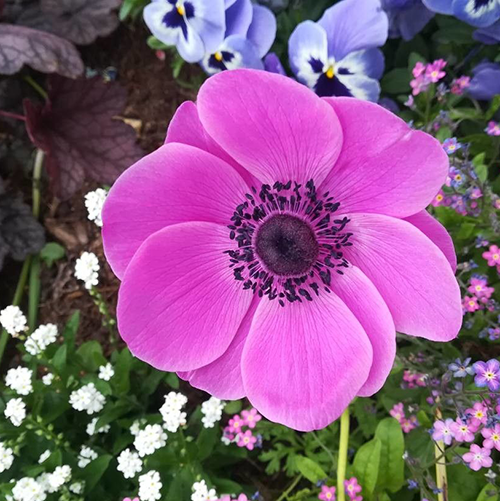
Sylphide features velvety, bright, violet-pink, poppy-like blooms adorned with a powdery dome of black stamens at their center. Blooming mid-late spring, this Mona Lisa cultivar is quite prolific, with up to 18 blooms per plant! Borne atop sturdy stems above clumps of finely divided, ferny leaves, they attract butterflies and make wonderful cut flowers. They thrive in the sunny garden where their broad, bright faces are highly appealing. Perfect for beds, rockeries or containers, and an absolute must for the cutting garden. 18-24”.
10 / $5.00
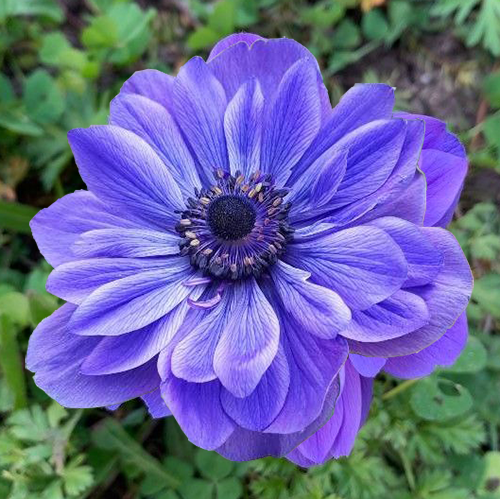
This big-bloomer won’t disappoint- the long-lasting blooms are a favorite of florists with their multi-layered petals that are bright, cheerful and yet elegant. This varietal is a good pollinator attractor, and while they do best in full sun, they will tolerate some shade. 16”
5 / $6.50
Camas
A member of the asparagus family, Camassia is a genus that is exclusively indigenous to North America. This was and remains a common food for many Indigenous peoples such as the Coast Salish, Kutenai, Blackfoot, Cree, and Nimíipuu, among many others. On Vancouver Island, blue camas was cultivated by controlled burns in the Garry Oak meadows. While white camas is commonly thought to be poisonous, it turns out that the infamous ‘Deathcamas’ is actually a name used for a number of species in entirely different families, mostly the family Melanthieae. Here, only the blue camas was traditionally harvested, and we recommend that you do your own research before sampling the white varietal of Camassia leichtlinii, as this remains an under-researched topic.
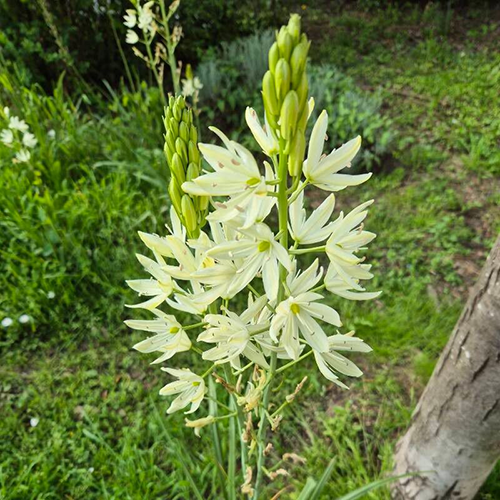
This is the rare form of Camas, and its edibility is unclear and under-researched, but it makes up for it with the gorgeous spires of white star-shaped blooms. Deer resistant. Pollinator friendly. 44″
3 / $8.50

Also Indigenous to the PNW, but is taller than the common Camas. Naturalizes easily. Deer resistant. Pollinator friendly. 30″
3 / $9.50
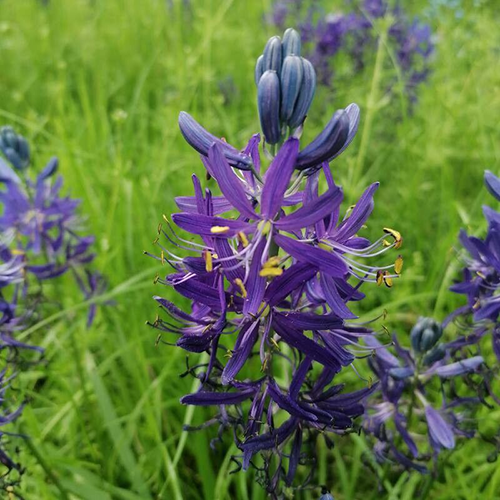
Known as Common, Meadow, or Small Camas. PNW Native. Naturalizes easily. Deer resistant. Pollinator friendly. 15″.
10 / $8.50
Other Garden Accents
These beauties are often unique and under-represented in the home garden, despite their beauty and interest.
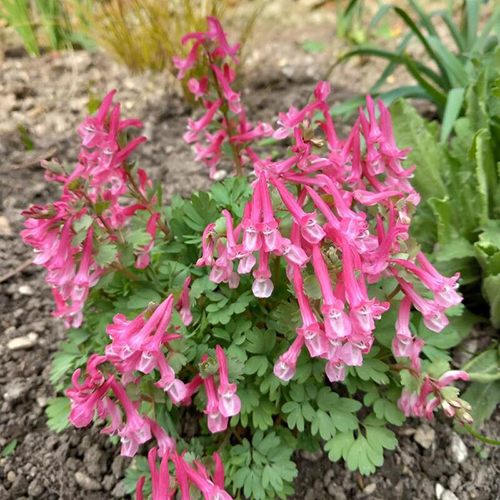
This award-winning, demure woodlander features deep pink tubular blooms with flashes of white on its spurs. As they mature, they shift to a paler shade of pink. Commonly known as Fumewort or Bird in a Bush, C. solida is a bee-loved tuberous root native from the Balkans to Scandinavia. Its name translates from Latin as Crested Lark, for its floral spurs. Blooming profusely in mid-late spring, flowers sit proudly above the handsome, fern-like foliage of blue-green divided leaves. Commonly grown in sun-dappled woodlands, this deer-proof charmer is tolerant of a bit more moisture than most bulbs, and requires rich, well-draining soil in filtered sunlight to partial shade. It is ridiculously easy to grow, and is perfect for borders, rockeries or woodland areas. Summer dormant. 6-10” tall and wide. Spring ephemeral.
5 / $6.50
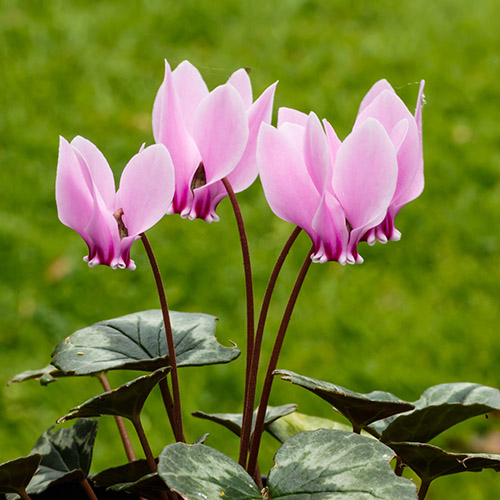
Popping up in the late summer garden when most plants have finished blooming, award-winning Ivy-Leaved Cyclamen bejewels the fall garden and creates a captivating sight when massed. Opening before or with its leaves, elegant nodding flowers, in shades of magenta to white, 1” across, rise above equally decorative, variegated foliage of large, ivy-shaped leaves in shades of green, gray, pewter or silver. The sometimes fragrant blooms are borne on 4-6” stems and feature gracefully upswept petals, darker around the mouth. Long-lasting, it creates an almost evergreen ground cover that adds colour and beauty to the garden during the winter and well into spring. Native to the Mediterranean region, this cyclamen is the hardiest, most robust, and easiest cyclamen to grow and will self-seed and naturalize freely if left undisturbed. 4-6’ tall and 6-12” wide.
2 / $9.50
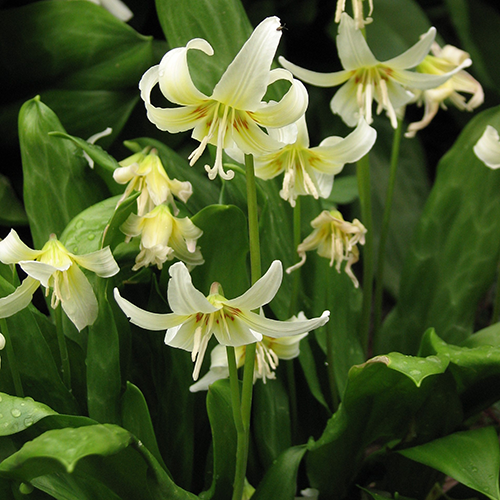
This award-winning Fawn Lily boasts up to 10 graceful blooms per stem, opening creamy and maturing to pure white. The 2” nodding blooms reveal glowing chartreuse-yellow centers, each petal etched with cinnamon-red markings around the creamy anthers. With rich green leaves, softly mottled with brown and white, this woodlander likes moisture, and will multiply happily in a shady spot, and appreciate an annual mulch with leaf mould. Mid-spring. 8”
3 / $11.50
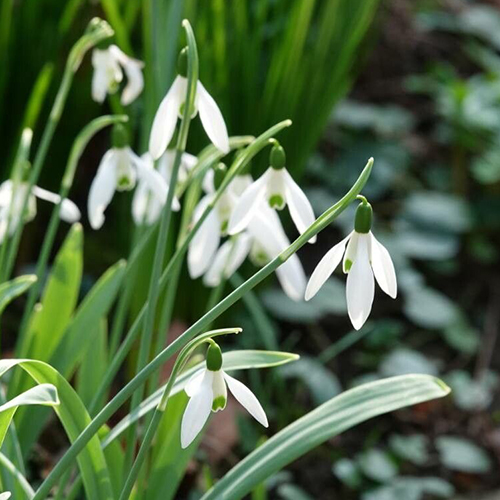
One of the ‘giant’ snowdrops, ‘Mount Everest’, features lovely, large, 1” blooms and wide, strappy leaves. The giant snowdrops (usually twice the height of most snowdrops) are the first to bloom, a few weeks before the common snowdrops. Mount Everest is a fast-growing, strong variety perfect for naturalizing in woodland shade. 8-10”
5 / $4.50

Double Snowdrops. Robust and incredibly attractive, this double snowdrop produces dainty, nodding white flowers, delicately marked with a green spot at the apex of each petal. The slightly fragrant, fluffy blooms arise atop foliage of narrow, greenish-gray leaves. Deer resistant. Fragrant. Rabbit Resistant. RHS AGM Winner. 6-8”.
5 / $6.50
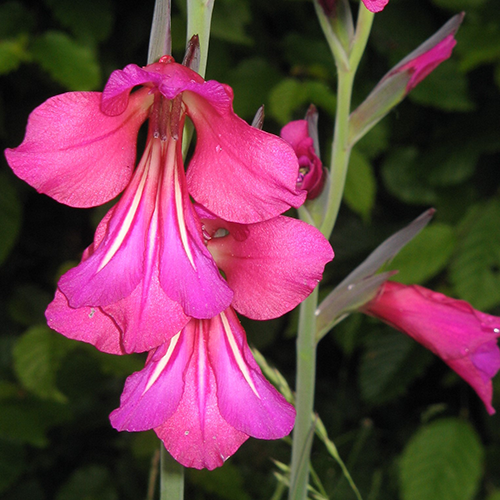
Native to the Mediterranean area, award-winning Gladiolus communis subsp. byzantinus (Byzantine Gladiolus) features narrow sword-shaped leaves in a fan of 3-5 erect flowering spikes, each bearing up to 15 bold, magenta funnel-shaped flowers, 2” wide. This hardy, eye-catching beauty blooms late spring-early summer, grows 2-3’ tall, and gradually spreads to form clumps. Attracts butterflies and hummingbirds, and makes a great cut flower. 24-36”
10 / $8.50

Also known as “Summer Snowflake”, these beauties actually appear in mid-spring, looking like a cross between a bluebell and a snowdrop with a delicate spot of green at the ends of their petals. Deer resistant. 24″.
5 / $7.50
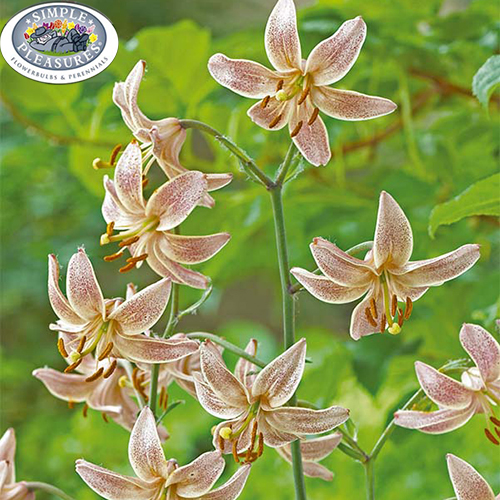
This lightly scented, charming martagon hybrid, produces bountiful mauve-pink blossoms adorned with white edges and delicately sprinkled with dark pink/red spots. Resembling a Turk’s cap with their strongly recurved petals (hence the common name), the downward facing blooms form a pretty floral candelabra show with up to 50 blooms/stem. Although they may take a year to get settled, they are Ideal for naturalizing in light woodland conditions, gradually forming a grove over time. 24-36″
$8.50 ea.
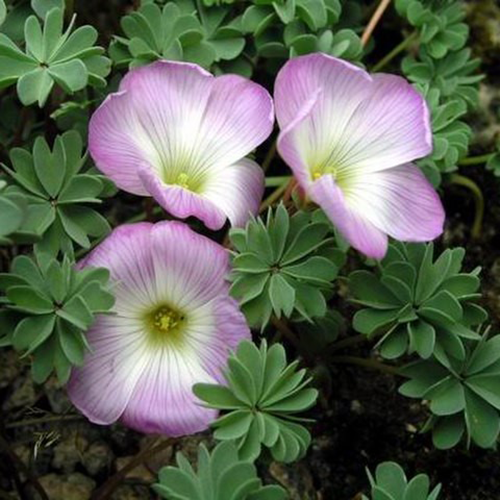
Silver Shamrock is a bulbous perennial forming a dense clump of finely incised gray-green leaves made up of several heart-shaped leaflets. The demure white blooms, 1” across, are flushed with purple and adorned with lilac veins above the handsome foliage. Unlike its rowdier cousins, this Oxalis does not spread by underground rhizomes, but clumps only around the bulb. Late spring. 4”
5 / $6.50
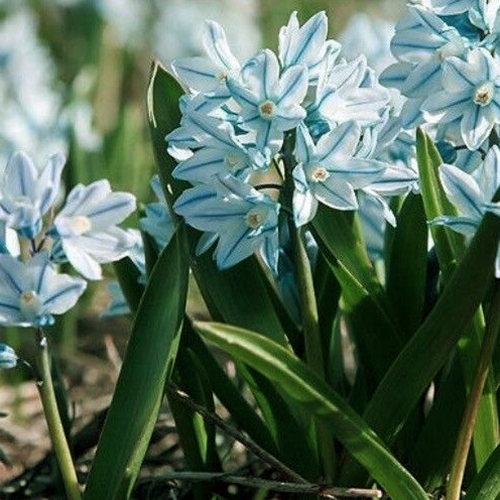
Similar to more common scillas, these boast larger clusters of pale blue-white flowers with a deeper stripe of blue on the outside of the bell. Fragrant. Deer resistant. 6″.
20 / $5.50
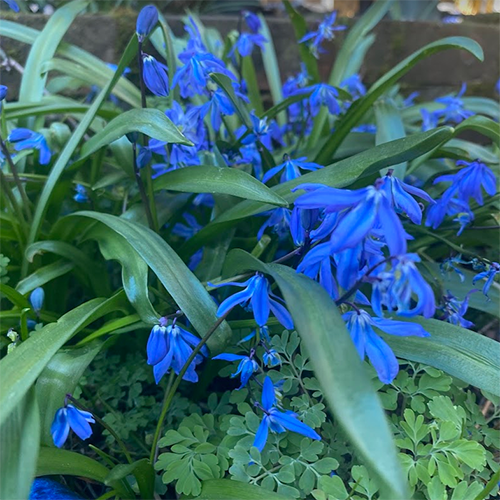
Siberian Squill boasts intense blue, nodding flowers (2-5 per stem) in early to mid spring. Easy to grow, and very hardy, it’s a great naturalizer, as it multiplies and comes back year after year, turning the landscape into a sea of true blue. Looks best when planted in large drifts. 3-6”
10 / $5.50
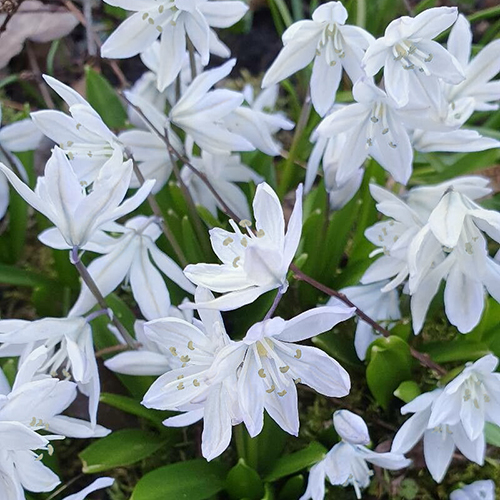
Among the earliest of spring bloomers, this white form of Siberian Squill bears perfectly white, bell-shaped, nodding blooms (2-5 per stem) in early-mid spring. Each bulb produces 3 – 4 flower stems, making them small workhorses in the spring garden. Easy to grow, and very hardy (Z2), it’s a great naturalizer, as it multiplies and comes back year after year, turning the landscape into a sea of white. Looks best when planted in large drifts, and is absolutely stunning when massed under trees or shrubs, in sweeping drifts in woodlands or wild areas, or naturalized in the lawn. 3-6”
10 / $5.50
